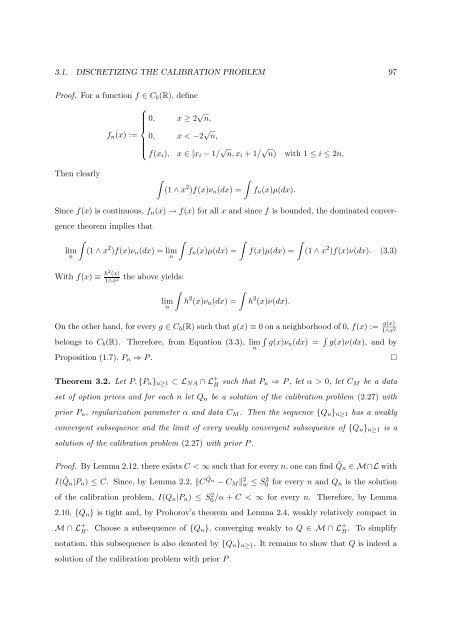Processus de Lévy en Finance - Laboratoire de Probabilités et ...
Processus de Lévy en Finance - Laboratoire de Probabilités et ...
Processus de Lévy en Finance - Laboratoire de Probabilités et ...
Create successful ePaper yourself
Turn your PDF publications into a flip-book with our unique Google optimized e-Paper software.
3.1. DISCRETIZING THE CALIBRATION PROBLEM 97<br />
Proof. For a function f ∈ C b (R), <strong>de</strong>fine<br />
⎧<br />
0, x ≥ 2 √ n,<br />
⎪⎨<br />
f n (x) := 0, x < −2 √ n,<br />
⎪⎩<br />
f(x i ), x ∈ [x i − 1/ √ n, x i + 1/ √ n) with 1 ≤ i ≤ 2n,<br />
Th<strong>en</strong> clearly<br />
∫<br />
∫<br />
(1 ∧ x 2 )f(x)ν n (dx) =<br />
f n (x)µ(dx).<br />
Since f(x) is continuous, f n (x) → f(x) for all x and since f is boun<strong>de</strong>d, the dominated converg<strong>en</strong>ce<br />
theorem implies that<br />
lim<br />
n<br />
∫<br />
(1 ∧ x 2 )f(x)ν n (dx) = lim<br />
n<br />
∫<br />
∫<br />
f n (x)µ(dx) =<br />
∫<br />
f(x)µ(dx) =<br />
(1 ∧ x 2 )f(x)ν(dx). (3.3)<br />
With f(x) ≡ h2 (x)<br />
1∧x 2<br />
the above yields:<br />
∫<br />
∫<br />
lim h 2 (x)ν n (dx) =<br />
n<br />
h 2 (x)ν(dx).<br />
On the other hand, for every g ∈ C b (R) such that g(x) ≡ 0 on a neighborhood of 0, f(x) := g(x)<br />
1∧x 2<br />
belongs to C b (R). Therefore, from Equation (3.3), lim<br />
n<br />
∫<br />
g(x)νn (dx) = ∫ g(x)ν(dx), and by<br />
Proposition (1.7), P n ⇒ P .<br />
Theorem 3.2. L<strong>et</strong> P, {P n } n≥1 ⊂ L NA ∩ L + B such that P n ⇒ P , l<strong>et</strong> α > 0, l<strong>et</strong> C M be a data<br />
s<strong>et</strong> of option prices and for each n l<strong>et</strong> Q n be a solution of the calibration problem (2.27) with<br />
prior P n , regularization param<strong>et</strong>er α and data C M . Th<strong>en</strong> the sequ<strong>en</strong>ce {Q n } n≥1 has a weakly<br />
converg<strong>en</strong>t subsequ<strong>en</strong>ce and the limit of every weakly converg<strong>en</strong>t subsequ<strong>en</strong>ce of {Q n } n≥1 is a<br />
solution of the calibration problem (2.27) with prior P .<br />
Proof. By Lemma 2.12, there exists C < ∞ such that for every n, one can find ˜Q n ∈ M∩L with<br />
I( ˜Q n |P n ) ≤ C. Since, by Lemma 2.2, ‖C ˜Q n<br />
− C M ‖ 2 w ≤ S 2 0 for every n and Q n is the solution<br />
of the calibration problem, I(Q n |P n ) ≤ S0 2 /α + C < ∞ for every n. Therefore, by Lemma<br />
2.10, {Q n } is tight and, by Prohorov’s theorem and Lemma 2.4, weakly relatively compact in<br />
M ∩ L + B . Choose a subsequ<strong>en</strong>ce of {Q n}, converging weakly to Q ∈ M ∩ L + B<br />
. To simplify<br />
notation, this subsequ<strong>en</strong>ce is also <strong>de</strong>noted by {Q n } n≥1 . It remains to show that Q is in<strong>de</strong>ed a<br />
solution of the calibration problem with prior P .
















